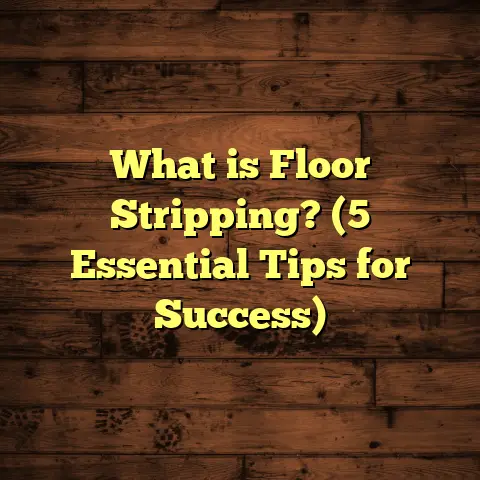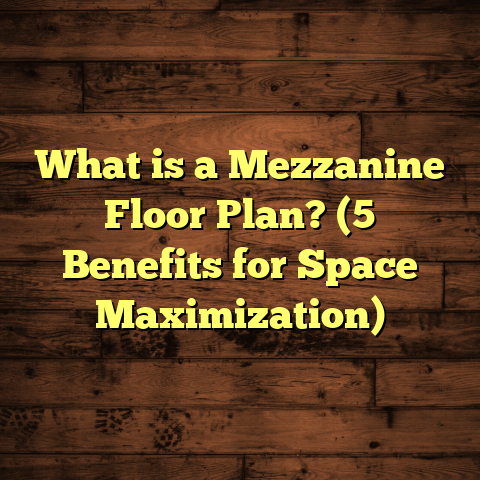What is the Most Common Type of Flooring? (5 Options Revealed!)
What is the Most Common Type of Flooring? (5 Options Revealed!)
Living in the Pacific Northwest, I’ve come to realize how much regional climate influences flooring choices. Here, for example, the dampness and frequent rain mean that floors need to handle moisture well, resist warping, and still look inviting when visitors come inside after a long hike or rainy day. It’s interesting to observe how my clients’ preferences shift based on where they live. Someone in Florida might pick something different than a homeowner in Minnesota or Texas.
Over the years of working as a flooring contractor and helping hundreds of homeowners across different states, I’ve noticed that despite all sorts of options out there, only a handful tend to dominate the market. So, what exactly is the most common type of flooring? What makes these materials suitable for so many homes? And how do you choose the best one for your living space?
Let me walk you through the five most common flooring options that I see day in and day out—hardwood, laminate, vinyl, tile, and carpet. Each option has unique strengths and weaknesses. I’ll share technical details, practical advice, real-world stories, and data-backed insights to help you understand what might work best for you.
What Exactly Does “Most Common Flooring” Mean?
When I talk about “most common flooring,” I’m referring to the types of flooring materials that are most frequently installed in residential homes across the United States and regions like mine. This includes new construction and renovation projects. It’s a blend of what people prefer for aesthetics, practicality, cost, and durability.
It’s important to understand that “common” doesn’t just mean “popular.” It also reflects availability, installation ease, and suitability for different environments. For example:
- Homeowners in humid climates may avoid solid hardwood because it can warp.
- Families with kids might choose carpet for comfort but worry about stains.
- People on a budget might lean toward laminate or vinyl.
The choice often comes down to balancing these factors.
Industry data supports what I see on the ground. For instance, according to a 2023 report from the U.S. Flooring Market Insights, hardwood makes up roughly 30% of residential flooring installations nationwide. Laminate holds about 20%, vinyl around 15%, tile another 15%, and carpet covers approximately 25%. These percentages vary by region but offer a clear snapshot of what’s common.
Hardwood Flooring: The Classic Staple
Hardwood flooring is probably what comes to mind first when people think about quality flooring. When I installed hardwood floors in my own home a few years ago, I was amazed at how they transformed the entire atmosphere—making everything feel warmer and more grounded.
What Makes Hardwood So Popular?
Hardwood floors are made from solid wood planks harvested from trees such as oak, maple, cherry, and walnut. Each plank is milled from one solid piece of wood, giving it natural beauty and durability.
Beyond just looks, hardwood is a long-term investment. According to the National Wood Flooring Association (NWFA), hardwood can last over 50 years if maintained properly—which means sanding and refinishing every decade or so.
Technical Details Worth Knowing
Hardwood has some vulnerabilities too. It naturally expands and contracts as humidity changes. That means in regions with high moisture—like the Pacific Northwest or Southeast—solid hardwood installed without proper subflooring or moisture barriers can warp or cup.
That’s why engineered hardwood has become popular recently. Engineered hardwood consists of a thin layer of real wood on top of plywood layers arranged crosswise for stability. This construction resists moisture better while still offering the authentic wood look.
A Story from My Work
I remember a client in Seattle who initially went with solid oak for their kitchen floor without considering moisture risks. After a particularly wet winter, several planks started to buckle near the sink area. We ended up replacing that section with engineered hardwood planks designed specifically for moisture resistance. They looked just as good but held up much better.
Cost Breakdown
Hardwood is often seen as a premium product because of its material cost and labor-intensive installation process. On average:
- Material costs: $5 to $10 per square foot
- Installation costs: $3 to $7 per square foot
- Total: $8 to $15 per square foot
For a medium-sized house of about 1,200 sq ft, that amounts to roughly $9,600 to $18,000.
Maintenance Tips
The key to long-lasting hardwood is regular maintenance:
- Clean gently with wood-friendly products.
- Avoid standing water.
- Use area rugs in high-traffic zones.
- Refinish every 7-10 years depending on wear.
Laminate Flooring: Affordable and Stylish
Laminate flooring has come a long way from its early days as a cheap alternative. These days, laminate can closely mimic real wood or stone at a much lower cost.
What Is Laminate Flooring?
Laminate is made up of four layers:
- Wear Layer: A clear protective surface that resists scratches.
- Design Layer: A high-resolution photo layer that imitates wood or stone.
- Core Layer: High-density fiberboard providing stability.
- Backing Layer: Adds moisture resistance and structural support.
This construction makes laminate durable and scratch-resistant but vulnerable to water damage if seams aren’t sealed properly.
Who Should Consider Laminate?
Laminate is perfect if you want a stylish floor on a budget or are doing a DIY install. It’s also great for families with pets or kids because it’s resistant to scratching and dents.
Popularity in Numbers
Laminate holds about 20% of the residential flooring market share in the U.S., according to Floor Covering Weekly’s 2023 report.
Real-Life Example
A family I worked with in Denver wanted wood-look floors but had a tight budget. We installed laminate throughout their main areas. Two years later, even with their energetic dog running around daily, the floors looked almost new—proof that laminate can handle wear well.
Installation Notes
Laminate uses click-lock panels that snap together without glue or nails—making installation faster and cheaper than hardwood.
Cost Breakdown
- Material costs: $1.50 to $4 per square foot
- Installation costs: $2 to $5 per square foot (DIY reduces this)
- Total: $2 to $9 per square foot
For 1,000 sq ft, you’re looking at $2,000 to $9,000 depending on quality and labor.
Vinyl Flooring: The Modern Marvel
Vinyl flooring has evolved dramatically over the last decade. Once seen as cheap linoleum, modern vinyl planks and tiles provide durability and water resistance with realistic textures.
Why Vinyl Is Gaining Ground
Vinyl is now one of the fastest-growing flooring types due to its versatility and price point.
Luxury Vinyl Tile (LVT) or Luxury Vinyl Plank (LVP) mimics wood grain or stone textures closely while being completely waterproof—a big plus for kitchens, bathrooms, and basements.
Technical Composition
Vinyl layers typically include:
- Clear wear layer
- Printed design layer
- Vinyl core (sometimes rigid for stability)
- Backing layer for support
Some types are glue-down while others have click-lock installation similar to laminate.
Market Share & Trends
In 2024, vinyl accounts for around 15-18% of residential floor installations nationwide — rising steadily due to new product innovations.
My Experience with Vinyl
One elderly couple I helped choose vinyl plank flooring appreciated how soft and warm it felt underfoot compared to tile but still resisted spills perfectly in their kitchen.
They told me how much easier it was to clean compared to carpet or hardwood — something that really matters if mobility becomes an issue later.
Cost Details
- Material costs: $2 to $7 per square foot
- Installation: $2 to $5 per square foot
- Total cost: $4 to $12 per square foot
Tile Flooring: Durable Beauty for Wet Areas
Tile has been around forever—and for good reason. If you want something extremely durable and waterproof with endless design options, tile is an excellent choice.
Tile Types You’ll Encounter
- Ceramic Tile: Made from clay; less dense than porcelain.
- Porcelain Tile: Denser and more water-resistant; ideal for high-moisture areas.
- Natural Stone: Marble, slate, granite—each requires special care.
Porcelain tile typically costs more but lasts longer and handles moisture better.
Why Tile Works Well
Tile can last 75+ years when installed properly—far longer than most other materials. It’s perfect for bathrooms, kitchens, mudrooms, and outdoor patios.
Regional Popularity
Tile is more common in southern states like Arizona or Florida where its cool surface helps offset heat indoors.
Installation Complexity
Tile installation requires skilled labor:
- Laying mortar evenly.
- Proper grout application.
- Sealing natural stone tiles.
Improper installation leads to cracking or water damage under tiles.
Cost Overview
- Ceramic tile: $5-$10 per sq ft installed
- Porcelain tile: $7-$15 per sq ft installed
- Natural stone tile: $10-$30+ per sq ft installed (depending on type)
Carpet: Softness That Feels Like Home
Carpet remains widespread because it brings warmth and sound absorption unlike any hard surface floor can offer.
Why People Still Love Carpet
Almost 25% of U.S. homes have carpet somewhere—especially bedrooms and family rooms where comfort is paramount.
Types of Carpet Fibers
- Nylon: Durable and stain-resistant.
- Polyester: Soft but less durable.
- Wool: Natural fiber with luxury feel but higher cost.
Carpet padding underneath makes walking more comfortable too.
Maintenance Realities
Carpet requires vacuuming weekly and professional cleaning every 12-18 months to keep allergens down and appearance fresh.
Personal Experience
Installing carpet for families with small children always reminds me why parents love it—it cushions falls during playtime and feels warm during cold seasons.
Cost Snapshot
Carpet materials range from $1-$5 per sq ft; installation adds about $1-$3 per sq ft; total typically $2-$8 per sq ft depending on quality.
Comparing These Flooring Options Side by Side
Here’s a quick comparison table based on my years in the field:
| Flooring Type | Cost (per sq ft) | Longevity (Years) | Water Resistance | Maintenance Level | Comfort Level |
|---|---|---|---|---|---|
| Hardwood | $8 – $15 | 50+ | Low | Medium | Medium |
| Laminate | $2 – $9 | 10 – 25 | Low-Medium | Low | Low-Medium |
| Vinyl | $4 – $12 | 10 – 20 | High | Low | Medium |
| Tile | $5 – $30 | 75+ | High | Low | Low |
| Carpet | $2 – $8 | 5 – 15 | Low | High | High |
How I Help Homeowners Choose Flooring That Fits Their Life
Having installed floors in everything from tiny apartments to sprawling houses over two decades, I always ask clients questions like:
- How much traffic will this floor get?
- Are pets or kids involved?
- Do you live in a humid or dry climate?
- What’s your budget?
- How long do you plan to keep this floor?
Those answers steer us toward the right solution. For example, if someone wants hardwood but lives somewhere humid with kids running around, I might suggest engineered hardwood or luxury vinyl plank as alternatives that look great but handle moisture better.
Using Tools Like FloorTally for Accurate Budgeting
One tool I often recommend is FloorTally — it helps estimate flooring costs based on local material prices and labor rates. This software also factors in waste percentages so you don’t end up short of materials mid-project.
I’ve used FloorTally on many jobs; it saves hours of back-and-forth quotes and gives homeowners confidence in their budgets upfront.
Final Thoughts (Without the Fuss)
Choosing flooring isn’t just about style—it’s about matching your living habits, climate conditions, budget constraints, and long-term plans. Hardwood remains king for timeless elegance; laminate offers affordability; vinyl shines for water resistance; tile excels in durability; carpet wins for comfort.
I hope my stories and data help you feel ready to tackle your next flooring project with confidence. If you want advice specific to your home or want me to review your options step-by-step, just ask!





